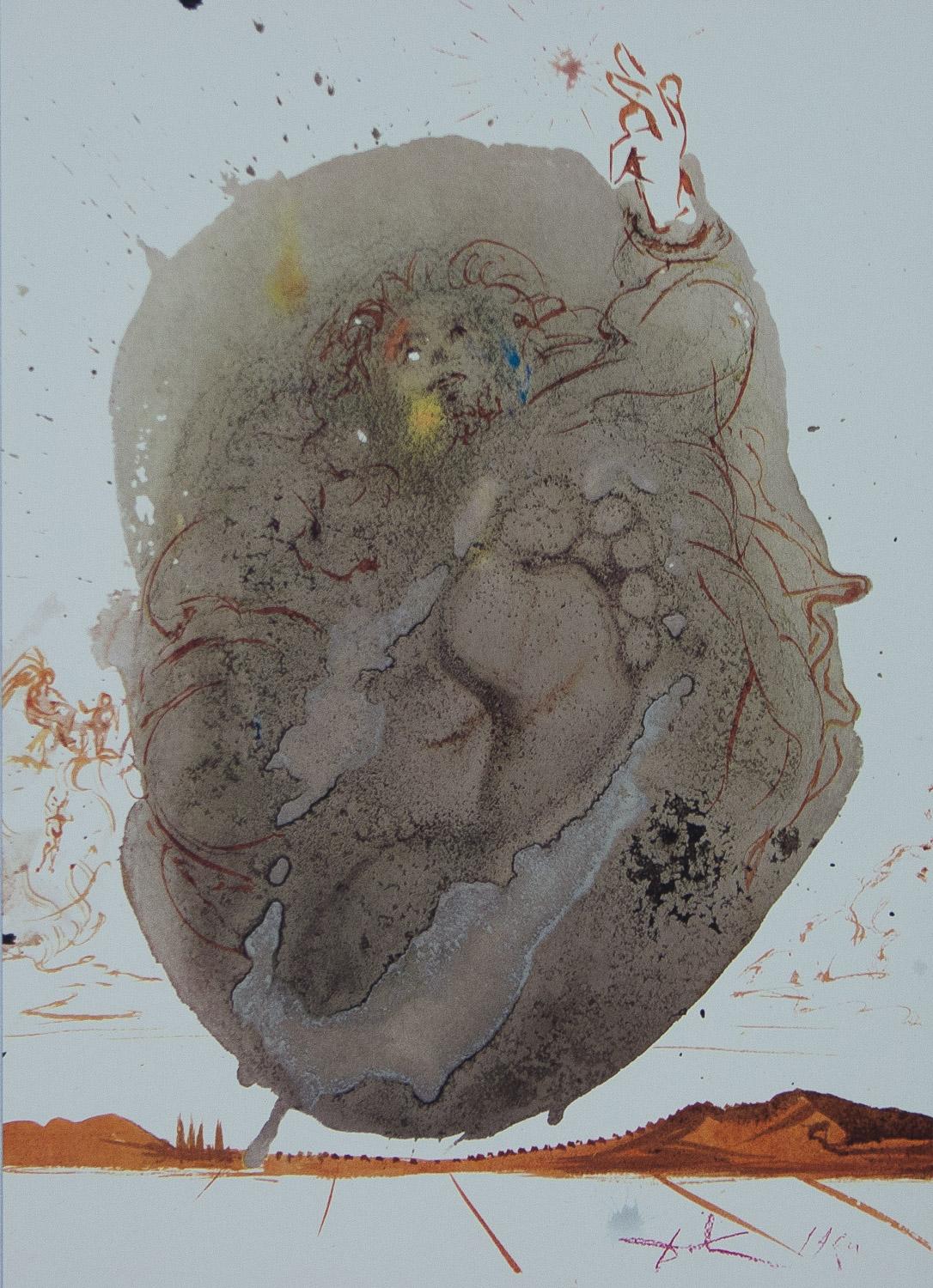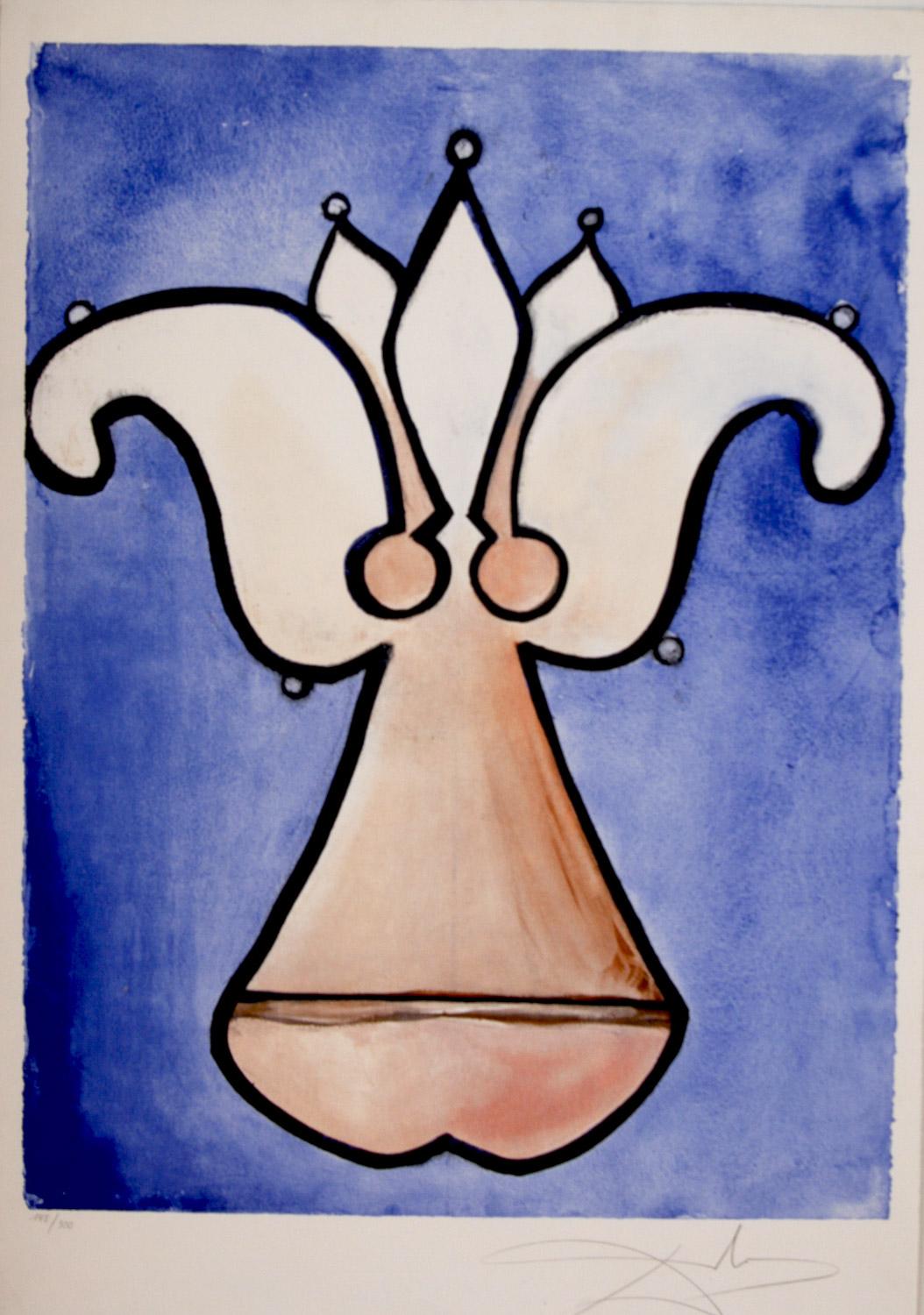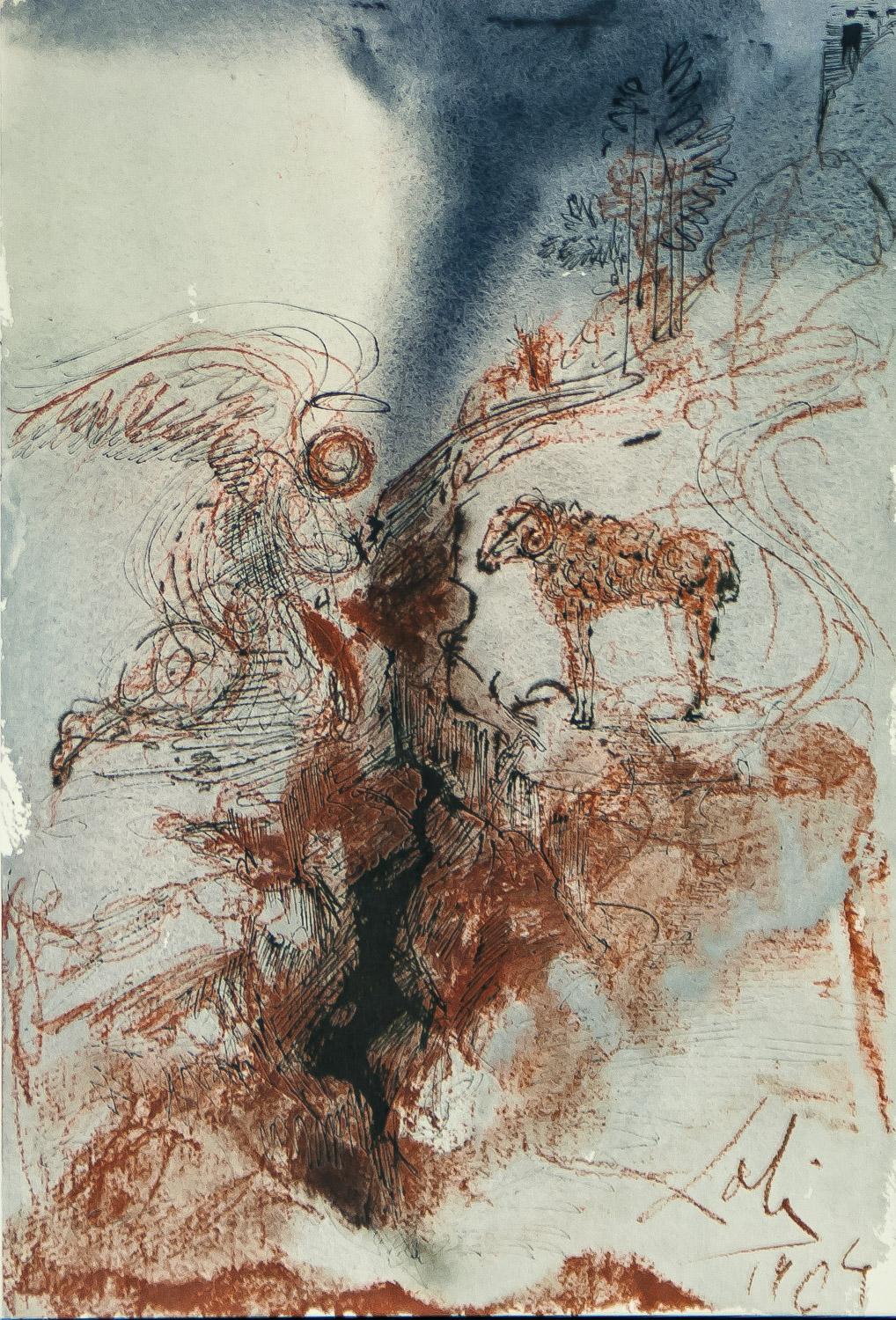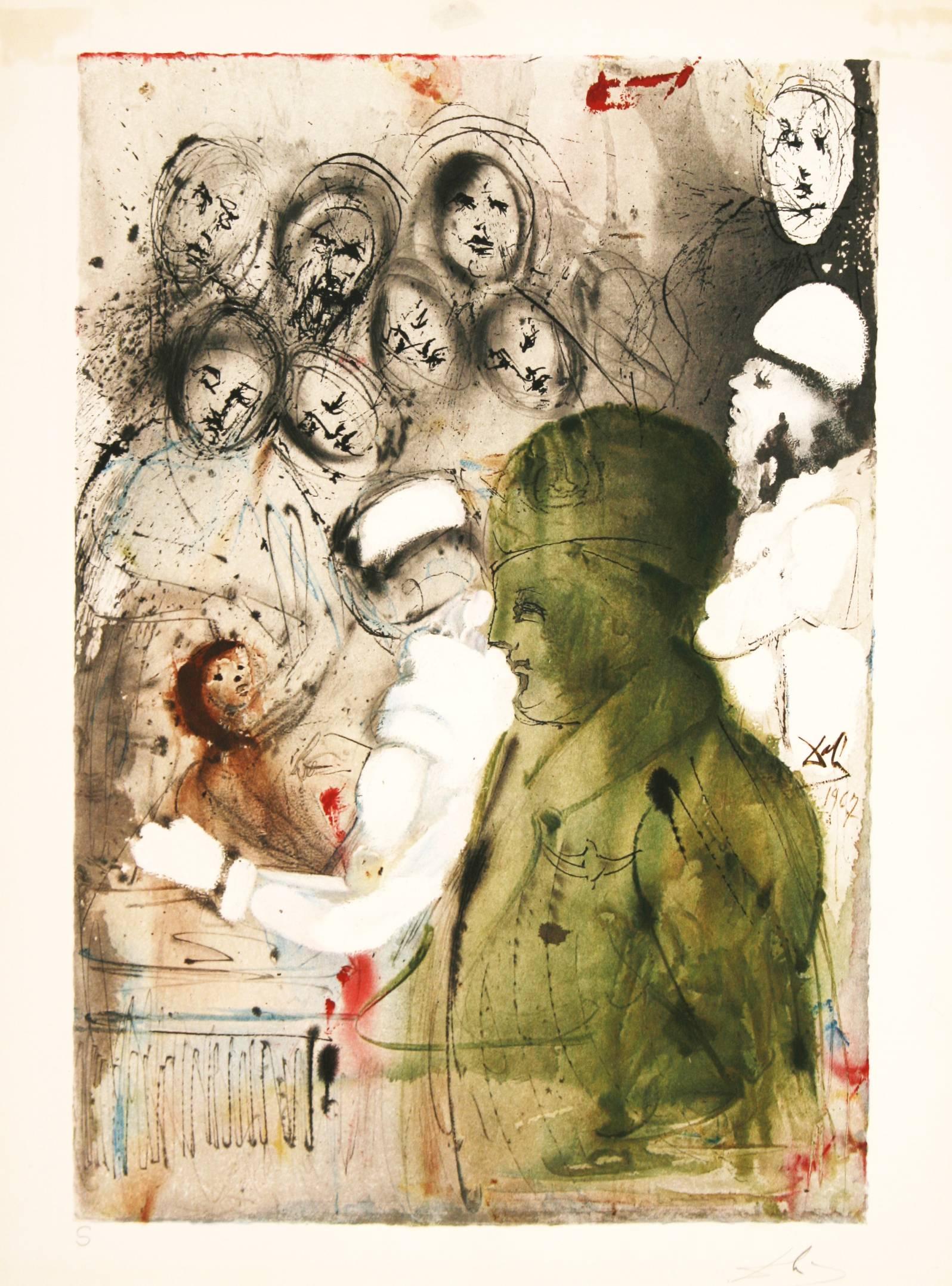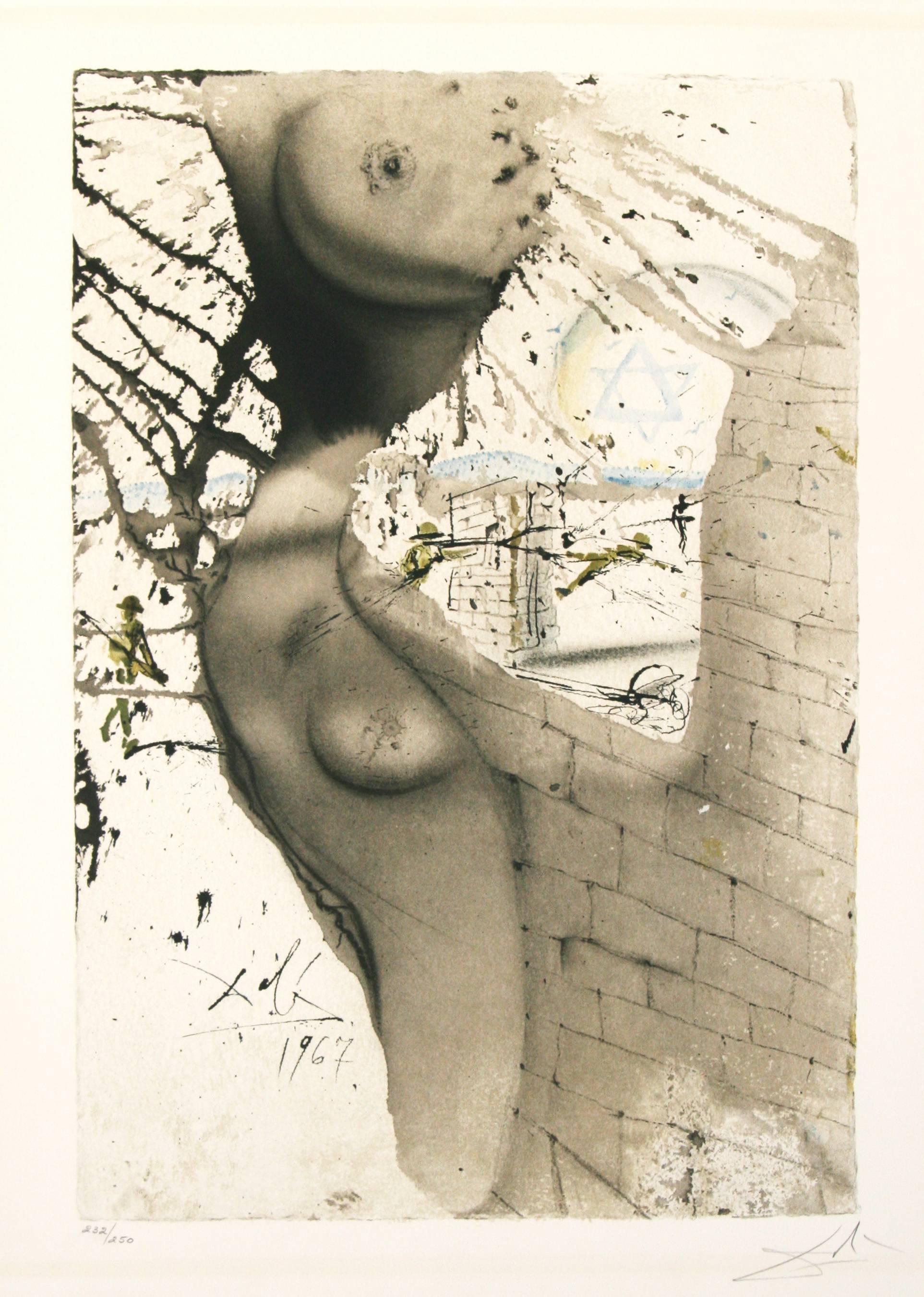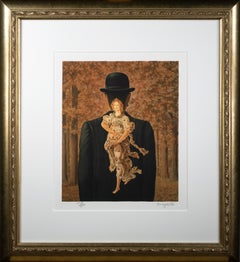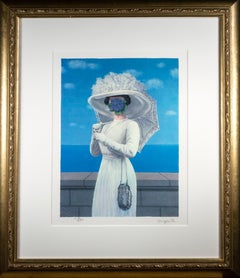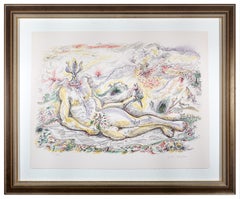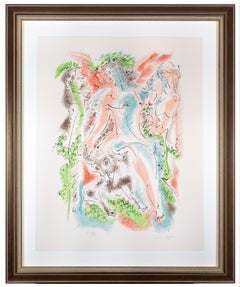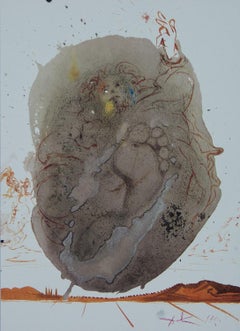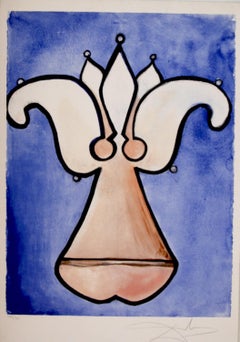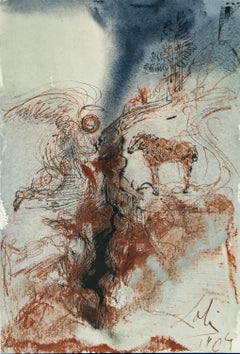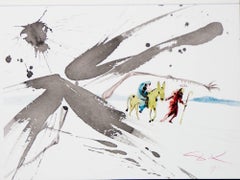Items Similar to "Back Cover of Derrière le Miroir #235" Original Lithograph
Want more images or videos?
Request additional images or videos from the seller
1 of 9
"Back Cover of Derrière le Miroir #235" Original Lithograph1979
1979
About the Item
"Back Cover of Derrière le Miroir #235, M 946" is an original lithograph by Marc Chagall. This Chagall is a graphic piece, with black lines on a white paper. The main figure is a jester with curly hair and checkered pants and sleeves. In his right hand he holds a smiling mask, which compliments his own melancholy face. His awkward body placement, with his left leg seemingly coming from his left shoulder, shows he is a contortionist. Bellow the jester's feet is a goat, a common motif for Chagall, who has a bouquet of flowers above its head.
Image: 15 x 11 in
Framed: 23.13 x 19.13 in
Marc Chagall was born in Liozno, near Vitebsk, now in Belarus, the eldest of nine children in a close-knit Jewish family led by his father Khatskl (Zakhar) Shagal, a herring merchant, and his mother, Feige-Ite. This period of his life, described as happy though impoverished, appears in references throughout Chagall's work. The family home on Pokrovskaya Street is now the Marc Chagall Museum.
He began studying painting in 1906 with a local artist, Yehuda Pen. In 1907, he moved to St. Petersburg. There he joined the school of the Society of Art Supporters and studied under Nikolai Roerich. It was here that he was exposed to experimental theater and the work of such artists as Gauguin. From 1908-1910 Chagall studied under Leon Bakst at the Zvantseva School of Drawing and Painting.
This was a difficult period for Chagall; at the time, Jewish residents were only allowed to live in St. Petersburg with a permit, and the artist was jailed for a brief period for an infringement of this restriction. Despite this, Chagall remained in St. Petersburg until 1910, and regularly visited his home town where, in 1909, he met his future wife, Bella Rosenfeld.
After gaining a reputation as an artist, Chagall left St. Petersburg to settle in Paris to be near the burgeoning art community in the Montparnasse district, where he developed friendships with such avant-garde luminaries as Guillaume Apollinaire, Robert Delaunay, and Fernand Léger. In 1914, he returned to Vitebsk and, a year later, married his fiancée, Bella. While in Russia, World War I erupted and, in 1916, the Chagalls had their first child, a daughter named Ida.
Chagall became an active participant in the Russian Revolution of 1917. Although the Soviet Ministry of Culture made him a Commissar of Art for the Vitebsk region, where he founded Vitebsk Museum of Modern Art and an art school, he did not fare well politically under the Soviet system. "Chagall was considered a non-person by the Soviets because he was Jewish and a painter whose work did not celebrate the heroics of the Soviet people."[6] He and his wife moved back to Paris in 1922. During this period, Chagall wrote articles, poetry and his memoirs (in Yiddish,) which were published mainly in newspapers (and only posthumously in book-form). Chagall became a French citizen in 1937.
With the Nazi occupation of France during World War II and the deportation of Jews, the Chagalls fled Paris, seeking asylum at Villa Air-Bel in Marseille, where the American journalist Varian Fry assisted in their escape from France through Spain and Portugal. In 1941, the Chagalls settled in the United States where he lived until 1948 (his wife Bella died in 1944.) His wife Bella, who appears in many of his paintings, bore him one child, Ida and then died on September 2, 1944. Bella and Ida appeared in many of his early and most famous paintings. In 1945, he began a relationship with his housekeeper Virginia Haggard McNeil, with whom he had a son, David. In the 1950s, they moved to a villa in Provence. Virginia left him in 1952, and Chagall married Valentina Brodsky (whom he called "Vava").
Jewish influence:
Chagall had a complex relationship with Judaism. On the one hand, he credited his Russian Jewish cultural background as being crucial to his artistic imagination. But however ambivalent he was about his religion, he could not avoid drawing upon his Jewish past for artistic material. As an adult, he was not a practicing Jew, but through his paintings and stained glass, he continually tried to suggest a more "universal message," using both Jewish and Christian themes.
Later life:
He traveled several times to Greece and visited Israel in 1957. During this time, he rediscovered a free and vibrant use of color. His works of this period are dedicated to love and the joy of life, with curved, sinuous figures. He also began to work in sculpture, ceramics, and stained glass. In a recent book review of Chagall's biography, author Serena Davies writes, "By the time he died in France in 1985 - the last surviving master of European modernism, outliving Joan Miró by two years - he had experienced at first hand the high hopes and crushing disappointments of the Russian revolution, and had witnessed the end of the Pale, the near annihilation of European Jewry, and the obliteration of Vitebsk, his home town, where only 118 of a population of 240,000 survived the Second World War.
She later adds that the book "leaves us finally with an image of a man who came from nowhere to achieve world-wide acclaim. Yet his fractured relationship with his Jewish identity - he was physically divorced from his homeland, and he wasn't a practicing Jew - was unresolved and tragic. He would have died with no Jewish rites, had not a stranger stepped forward and said the kaddish, the Jewish prayer for the dead, over his coffin.
- Creation Year:1979
- Dimensions:Height: 23.13 in (58.76 cm)Width: 19.13 in (48.6 cm)
- Medium:
- Movement & Style:
- After:Marc Chagall (1887 - 1985, French)
- Period:
- Condition:
- Gallery Location:Milwaukee, WI
- Reference Number:Seller: 6290d1stDibs: LU60535176862
About the Seller
4.9
Gold Seller
Premium sellers maintaining a 4.3+ rating and 24-hour response times
Established in 1966
1stDibs seller since 2017
429 sales on 1stDibs
Typical response time: 2 hours
- ShippingRetrieving quote...Shipping from: Milwaukee, WI
- Return Policy
Authenticity Guarantee
In the unlikely event there’s an issue with an item’s authenticity, contact us within 1 year for a full refund. DetailsMoney-Back Guarantee
If your item is not as described, is damaged in transit, or does not arrive, contact us within 7 days for a full refund. Details24-Hour Cancellation
You have a 24-hour grace period in which to reconsider your purchase, with no questions asked.Vetted Professional Sellers
Our world-class sellers must adhere to strict standards for service and quality, maintaining the integrity of our listings.Price-Match Guarantee
If you find that a seller listed the same item for a lower price elsewhere, we’ll match it.Trusted Global Delivery
Our best-in-class carrier network provides specialized shipping options worldwide, including custom delivery.More From This Seller
View All"Le Bouquet tout fait (The Ready-made Bouquet), " Lithograph after Rene Magritte
By René Magritte
Located in Milwaukee, WI
"Le Bouquet tout fait (The Ready-made Bouquet)" is a color lithograph after a 1954 original painting by Rene Magritte. A bourgeois "little man" faces away from the viewer looking towards a fall forest. Flora, the goddess of flowers and season of spring, from Sandro Botticelli's "Primavera" is painted on the back of the man. This juxtaposes fall and spring.
Art: 12 x 9.75 in
Frame: 22.38 x 20.38 in
René-François-Ghislain Magritte was born November 21, 1898, in Lessines, Belgium and died on August 15, 1967 in Brussels. He is one of the most important surrealist artists. Through his art, Magritte creates humor and mystery with juxtapositions and shocking irregularities. Some of his hallmark motifs include the bourgeois “little man,” bowler hats, apples, hidden faces, and contradictory texts.
René Magritte’s father was a tailor and his mother was a miller. Tragedy struck Magritte’s life when his mother committed suicide when he was only fourteen. Magritte and his two brothers were thereafter raised by their grandmother.
Magritte studied at the Brussels Academy of Fine Arts from 1916 to 1918. After graduating he worked as a wallpaper designer and in advertisement. It was during this period that he married Georgette Berger, whom he had known since they were teenagers.
In 1926, René Magritte signed a contract with the Brussels Art Gallery, which allowed him to quit his other jobs and focus completely on creating art. A year later he had his first solo show at the Galerie la Centaurie in Brussels. At this show Magritte exhibited what is today thought of as his first surrealist piece, The Lost Jockey, painted in 1926. In this work a jockey and his steed run across a theater stage, curtains parted on either side. Throughout the scene, there are trees with trunks shaped somewhat like chess pawns with musical scores running vertically up their sides and branches sticking out from all angles. Critics did not enjoy this style of art; it was new, different, and took critical thought to understand, but The Lost Jockey was only the first of many surrealist artworks Magritte would paint.
Because of the bad press in Brussels, René and Georgette moved to Paris in 1927, with the hope that this center of avant-garde art would bring him success and recognition. In Paris, he was able to become friends with many other surrealists, including André Breton and Paul Éluard. They were able to learn from and inspire one another, pushing the Surrealist movement further forward.
It was also in Paris that Magritte decided to add text to some of his pieces, which was one of the elements that made his artwork stand out. In 1929, he painted one of his most famous oil works: The Treachery of Images. This is the eye-catching piece centered on a pipe. Below the pipe is written “Ceci n’est pas un pipe,” which translates to “This is not a pipe.” This simple sentence upset many critics of the time, for of course it was a pipe. Magritte replied that it was not a pipe, but a representation of a pipe. One could not use this oil on canvas as a pipe, to fill it with tobacco and smoke it. Thus, it was not a pipe.
In 1930, Magritte and Georgette moved back to Brussels. Though they would travel to his exhibitions elsewhere, their home going forward would always be in Brussels.
Magritte had his first American exhibition at the Julien Levy Gallery in New York City in 1936 and his first show in England two years later in 1938 at The London...
Category
2010s Surrealist Figurative Prints
Materials
Lithograph
"La Grande Guerre (The Great War), " Color Lithograph after Rene Magritte
By René Magritte
Located in Milwaukee, WI
"La Grande Guerre (The Great War)" is a color lithograph after the 1964 painting by Rene Magritte. A Victorian lady stands in white facing the viewer. A bouq...
Category
2010s Surrealist Figurative Prints
Materials
Lithograph
"Le Prince Iris, " Surrealist Lithograph From "Je Reve" Portfolio
By André Masson
Located in Milwaukee, WI
"Le Prince Iris" is an original color lithograph by Andre Masson. The artist signed the piece lower right in pencil and wrote the edition number, H.C. XXV/X...
Category
1970s Surrealist Figurative Prints
Materials
Lithograph
"Bacchanale from Je Reve (I Dream) Portfolio, " Original Color Lithograph
By André Masson
Located in Milwaukee, WI
"Bacchanale" is an original color lithograph by Andre Masson. This piece is from the Je Reve (I Dream) portfolio and is edition number H.C. XVV/XVV. Masson signed the piece in pencil...
Category
1970s Surrealist Figurative Prints
Materials
Lithograph
"La Reconnaissance Infinie (The Infinite Recognition)" Litho after Rene Magritte
By René Magritte
Located in Milwaukee, WI
"La Reconnaissance Infinie (The Infinite Recognition)" is a color lithograph after the 1963 painting by Rene Magritte. Two of Magritte's bourgeois "littl...
Category
2010s Surrealist Figurative Prints
Materials
Lithograph
"Satan" from "Je Reve" portfolio, Surrealist Lithograph, Signed
By André Masson
Located in Milwaukee, WI
"Satan" is an original color lithograph by Andre Masson. This piece is from the "Je Reve" (I Dream) portfolio of 1975. The edition number, written lower left, is H.C. XXV/XXV. The ar...
Category
1970s Surrealist Figurative Prints
Materials
Lithograph, Paper
You May Also Like
Let Us Make Man in our Image and Likeness Dali lithograph Biblia Sacra 1964
By Salvador Dalí
Located in Paonia, CO
Let Us Make Man in our Image and Likeness shows God lying on his back facing upwards with his left hand raised, two fingers pointing upwards in the midst of creating man repres...
Category
1960s Surrealist Abstract Prints
Materials
Lithograph
Lys from Anamorphoses suite by Salvador Dali
By Salvador Dalí
Located in Paonia, CO
Salvador Dali’s Lys ( Anamorphoses ) is one of five lithographs from the suite “Anamorphoses ” published by Jean Schneider, Basil 1972. According to Albert Field when one of these prints is placed flat on a table with a cylindrical mirror...
Category
1970s Surrealist Abstract Prints
Materials
Lithograph
The He-Goats Of The Wild She-Goats On The Face Of The Earth Biblia Sacra by Dali
By Salvador Dalí
Located in Paonia, CO
The He-Goats Of The Wild She-Goats On The Face Of The Earth shows the angel Gabriel hovering on the left side of a tornado. He has come to help Daniel interpret his vision about ...
Category
1960s Surrealist Abstract Prints
Materials
Lithograph
Out of Egypt I Have Called my Son Biblia Sacra Salvador Dali
By Salvador Dalí
Located in Paonia, CO
Out of Egypt I Have Called my Son shows the Holy family departing from Egypt trekking through the desolate landscape of the desert. Joseph is leadin...
Category
1960s Surrealist Abstract Prints
Materials
Lithograph
Aliyah, Convenant: Eternal Circumcision lithograph by Salvador Dali
By Salvador Dalí
Located in Paonia, CO
Salvador Dali's Aliyah, Convenant: Eternal Circumcision is from the Aliyah, Rebirth of Israel Suite which was created by Salvador Dali for the 20th anniversary of the proclamation...
Category
1960s Surrealist Figurative Prints
Materials
Lithograph
Aliyah, Return, O Virgin of Israel Salvador Dali original lithograph
By Salvador Dalí
Located in Paonia, CO
Salvador Dali ( 1904 - 1989 )
Aliyah, Return, O Virgin of Israel, Aliyah suite
edition 232/ 250
published Shorewood Press 1968 on Arches paper
paper size 25 x 19.63
image size 20....
Category
1960s Surrealist Figurative Prints
Materials
Lithograph
